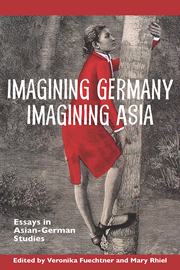Book contents
- Frontmatter
- Contents
- Acknowledgments
- Introduction
- Part I Contemporary Challenges to German Borders and Identities
- 1 East-West Globality and the European Mode of Film Production
- 2 Citizenship-Shifting: Race and Xing-Hu Kuo's Claim on East German Memory
- 3 Narratives of Transnational Divide: The Vietnamese in Contemporary German Literature and Film
- 4 Factories on the Magic Carpet: Heimat, Globalization, and the “Yellow Peril” in Die Chinesen kommen and Losers and Winners
- Part II Travel and Representation
- Part III Asia Inhabits Germany's Cultural and Intellectual History
- Bibliography
- Notes on the Contributors
- Index
4 - Factories on the Magic Carpet: Heimat, Globalization, and the “Yellow Peril” in Die Chinesen kommen and Losers and Winners
from Part I - Contemporary Challenges to German Borders and Identities
- Frontmatter
- Contents
- Acknowledgments
- Introduction
- Part I Contemporary Challenges to German Borders and Identities
- 1 East-West Globality and the European Mode of Film Production
- 2 Citizenship-Shifting: Race and Xing-Hu Kuo's Claim on East German Memory
- 3 Narratives of Transnational Divide: The Vietnamese in Contemporary German Literature and Film
- 4 Factories on the Magic Carpet: Heimat, Globalization, and the “Yellow Peril” in Die Chinesen kommen and Losers and Winners
- Part II Travel and Representation
- Part III Asia Inhabits Germany's Cultural and Intellectual History
- Bibliography
- Notes on the Contributors
- Index
Summary
With its ascent as one of the world's strongest economies, China now appears globally in a variety of representational modes. Since the turn of this century, a great number of works, both fiction and non-fiction, have been published that capture the incessant flow of goods and services between Germany and China. Such transnational activity presents intriguing material, particularly for documentary filmmakers. This essay focuses on two films, a documentary, and a feature film originally meant to be a documentary. They both involve moving a German factory to China but also, through a difference of twenty years, register the different stages in China's development and the German reaction to it. In each case the transplantation of factories takes place in conjunction with the unemployment or early retirement of the factory's former employees, who become “displaced persons” in their own society. The encounter of German and Chinese workers under these circumstances anticipates narratives characterized by anxieties, conflicts, and cultural stereotypes. The little-known comedy by Manfred Stelzer entitled Die Chinesen kommen (The Chinese are coming, 1986) features the disassembly of a factory in a small Bavarian town by a handful of Chinese workers who will then rebuild it in China. Stelzer interestingly labels his work a “Bavarian-Chinese Heimatfilm,” which suggests that he intentionally places his film in the long tradition of the German Heimat genre.
- Type
- Chapter
- Information
- Imagining Germany Imagining AsiaEssays in Asian-German Studies, pp. 64 - 86Publisher: Boydell & BrewerPrint publication year: 2013



